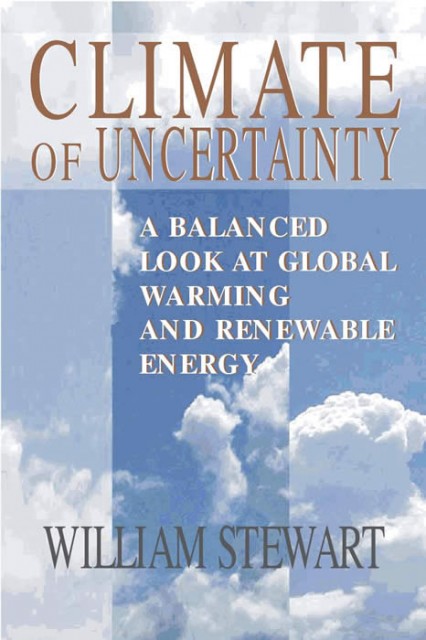 Climate of Uncertainty
Climate of Uncertainty
GLOBAL WARMING AND SCIENCE FICTION
I'm back at Readercon. Being here has led me to reflect on how last year's Readercon affected me. One of the panels I attended last year was entitled “Global Warming and Science Fiction,” hosted Gayle Surrette, with Paolo Bacigalupi, Paul Di Filippo, Alexander Jablokov and Steve Popkes.
The goal of the panel was to compare how “the dangers of nuclear weapons and nuclear war were common themes in mid-twentieth century science fiction, even before Hiroshima and Nagasaki. The nearest comparable danger today is anthropogenic global warming. It’s our impression that SF has not given to AGW the same level of attention that it gave to nuclear matters in the past, and has more often treated the issue as world-building background than placed it at the center of stories...”
As Andrew Liptak noted in his review of the panel:
There are some major differences that were noted between the two; nuclear warfare was generally regarded as an event that was outside of the general population’s control, removed by several levels of authority, while the nature of global warming is something that is really the cumulative result of the general population. Where one is a wholly dramatic, singular (or limited) event with massive consequences at the onset, global warming is something that has arisen slowly, with little attention paid to it and with the general population not likely to take any major steps to change until there are catastrophic results.
The panel inspired me to re-examine the role that global warming plays in Imprinted, my screenplay adaptation of “Rub-a-Dub,” the short story by Daniel Galouye. Galouye published the story in 1968 as part of a collection entitled Project Barrier.
For Galouye in 1968, the desire to explore Alpha Centauri was enough motivation to send a space ship on an eight year trip, manned only by a twelve-year-old girl who is controlled at various times by three male astronauts who have been imprinted on her brain. At the time that Galouye wrote “Global Warming” or “Climate Change” were not commonly used terms, but as part of the adaptation process I have chosen to use climate change as the motivation for the trip.
In Imprinted, the former United States has suffered so much social unrest due to extreme weather, earthquakes, floods, storms, tornadoes and hurricanes that numerous cities are now uninhabitable. The country has broken up into a handful of territories; the story takes place in what was formerly known as Florida, much of which is now underwater.
Because the topic of climate change is so complex I have read a series of books and watched a few films, which I will review in this blog over the next few months. The first book to come to my attention was the acclaimed Climate of Uncertainty: A Balanced Look At Global Warming and Renewable Energy by William F. Stewart.
 William Stewart
William Stewart
Stewart is remarkably equipped to write a book like this: he is a lawyer and was head of a nationally recognized Climate Change and renewable Energy practice–where he served clients on a broad range of global warming-related topics. He has lectured on climate change at numerous national symposia, and his work has been featured by NBC News, The National Law Journal, AM Best’s International Financier, The Wall Street Journal and dozens of other publications. Most importantly, he has worked hard in this book to make the overwhelmingly confusing array of issues that make up the climate change debate accessible to ordinary citizens. In fact, he was inspired to write the book when his daughter Megan asked him for a basic introduction to the issue and he could not think of a good one to give her (however he does give a list of ten books on the issue, from various political viewpoints, on his blog).
The text of the book itself (not including notes) is a packed but easy to read 159 pages. He provides easy to grasp explanations of fairly complex concepts, starting with the greenhouse effect itself, as well as natural “feedback loops” that accelerate the heating, such as the ice-albedo effect and the permafrost/carbon feedback and the escalating effect of forest dieback. He provides an overview of studies showing the Earth is heating and also of factors that complicate the analysis of that data like El Nino, volcanoes, and global dimming.
It’s clear that Stewart is not a climate change skeptic. Although he is not an alarmist, his chapter on “future manifestations of global warming” can’t help but alarm: lethal heat waves, rising seas, changing precipitation patterns that lead to drought, floods, and wildfire, more intense hurricanes and storms, the endangerment and extinction of animal species like the polar bear, military conflicts arising out of the need to secure access to vital resources, and an increase in vectorborne diseases like malaria, dengue fever and yellow fever. In this chapter he quotes the prime mister of the Pacific Island nation of Tuvalu:
We live in constant fear of the adverse impact of climate change. For a coral atoll nation, sea level rise and more severe weather events loom as a growing threat to our entire population. The threat is real and serious, and is of no difference to a slow and insidious form of terrorism against us. (Safautu Sapoanga in an address to the 58th Session of the United Nations Assembly in New York on September 3, 2004).
Stewart's chapter on the future manifestations of global warming is counterbalanced by three chapters on possible solutions, from population control to renewable energies and a chapter on “least-flawed” non-renewable alternatives. He also mentions some of the "antidotes" such as the experiments to seed the Southern Ocean with iron to increase the ability of phytoplankton to absorb carbon dioxide, a concept I adapted for use in my screenplay.
What is most impressive about this book is that although not a skeptic himself, Stewart devotes nearly half of his text to the politics behind the debates on climate change and to the arguments of climate skeptics. Their positions and reasoning’s are explained as carefully as the research that shows the Earth is warming. He refers to studies from both sides of the debate and explains the history and mission of organizations like Intergovernmental Panel on Climate Change and an overview of its reports.
In short, Climate of Uncertainty is an excellent introduction to the complexity of the issues of climate change, both scientific and political. It should be required reading for seniors in high school and freshmen in college as well as anyone who needs a clear but unemotional introduction to the issue. The book can be ordered directly from Ocean Publishing or from Amazon.
